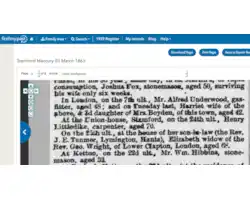When an orphan, age 6, turns up at his new school - and the paperwork says 'Robert', and he says he's 'Albert' – what's to be done? This is the story of Robert alias Albert, or should that be Albert alias Robert. Terry Jenkins recounts his research into the matter
Was it a simple slip of the pen that led to Albert Underwood becoming known as Robert as a child? And did this change of name encourage Albert to adjust other of his personal details, such as his age, as his life went on. Terry Jenkins investigates the tale of Albert William Underwood.
Recently, I was trying to trace the origins of an Albert Underwood who was born in London around 1861. From later evidence I knew he was born in the City itself, and his father's name was also Albert. The family were all listed in the 1871 Census: Albert (10) with parents Albert (30) and Isabella (29) in the parish of St Stephen, Coleman Street. Yet there was no birth for the boy in the General Register Office (GRO) registers. In fact, nobody called Albert Underwood was born in the City around this time, and there were only two such births in all the rest of London. Both were slightly later than 1861 – one in Rotherhithe in 1862, and the other in Westminster in 1864.
I decided to investigate…
I was able to dismiss the Rotherhithe birth immediately – this Albert was the son of Joseph and Betsy, and Rotherhithe is certainly not part of the City of London. However, the Westminster birth was more problematic. This boy was actually named Albert William, and I discovered that on 2 August 1870 (incorrectly transcribed as 1869), at the age of six, he was taken into the Strand workhouse. A day later he was transferred to the City of London workhouse. This was worrying, as it meant the authorities considered he was the City's responsibility – indicating he was born within the City boundaries. I decided to investigate further, although the lad appeared to be too young for the person I was searching for. And this is what I found.
This is what I found
Albert William was the son of Alfred John Underwood, born on 1 November 1864 in Houghton Street, Clare Market. This is the area just south of Lincoln's Inn Fields and north of Aldwych that now contains the London School of Economics. It lies on the extreme edge of Westminster, but is clearly within the parish of St Clement Danes. After all the changes in the area, all that remains of the street is a short section leading off Aldwych.
The boy's father, however, was Alfred, not Albert. Now most genealogical websites group these two names together, and it is true that people do muddle them. I don't think they would have done so in Queen Victoria's day! Nonetheless, I decided to press ahead with my research.
Alfred John Underwood was a gas fitter, who married his second wife, Harriet Boyden, on 23 May 1858 at St John's Church, Waterloo. His first wife, Anne Priscilla Sturges died in 1857, leaving him with two children: Charles and Catherine. His second wife bore him three further children, of whom the youngest was Albert William.
Orphaned infant years
And then, in the space of three weeks in February 1865, both parents died of typhus. The deaths occurred in the London Fever Hospital in Islington and, surprisingly, were reported in a couple of Lincolnshire newspapers. Harriet's mother, Mrs Boyden, lived in Stamford, and a report of the deaths can be found in the Stamford Mercury on 3 March.
The children were all taken into the Westminster workhouse in Cleveland Street (south of the Euston Road, beside the BT Tower). Albert William, who was just three months old, was then placed in a special facility that looked after orphan babes in Edmonton. The other children were sent to the poor law school in Hanwell, west London. The eldest child, Charles, stayed there for a week - he was 14 years old, and old enough to be immediately discharged and placed in employment. The other three stayed until they were also of an appropriate age to be discharged.
Albert William remained in Edmonton for the next five years. The records show that he moved up to the Infant section in September 1867, when he was 2½. He was then transferred back to the main workhouse in Westminster on 2 August 1870. Although the authorities must have known exactly where he was born, they transferred him to the City of London workhouse on 3 August. He was admitted using his full name: Albert William Underwood, aged 6. So they certainly knew who he was. Three weeks later, in his turn, he also was sent to the poor law school in Hanwell.
Robert alias Albert
He was discharged from the City workhouse on 25 August and, for some inexplicable reason, was admitted to the Hanwell school that same day as Robert Underwood. It is ridiculous to think that Albert William disappeared on the journey from central London - and someone else called Robert Underwood fortuitously turned up in his place on the same day. However, he appears in the Register of Admissions as Robert, and this is how he was officially known at the school. I can only assume that the official paperwork that accompanied him was badly written.
Nevertheless, I was still concerned that I might have inadvertently combined two separate children. Fortunately, I found another, later, school register which lists him as "Robert alias Albert" born 1864, admitted 25 August 1870, parents unknown. I can imagine that the boy protested that his name wasn't Robert from the day he arrived - but the authorities would not believe him: "Yes dear, but that's not what it says on the paper ...". Later, and grudgingly, they allowed him to use the name.
He was there for the census in April 1871, as were his older siblings Emily and Henry George.
(His two older siblings, Charles and Catherine had moved on.) One might think they would vouch for him - but they had not had any contact with him since birth. They may not even have remembered his existence - we are dealing with young children here.
‘Robert’s’ Army years
The school records show that 'Robert' was discharged from Hanwell on 21 October 1879 and joined the Army. It is now possible to trace his life in the Army records at The National Archives. These show that Bandsman No. 2865, Robert Underwood, served for nearly 20 years, and was discharged in 1899. The records state that his next of kin was a brother who lived in the King's Road, Chelsea. From the handwriting, it looks as though this entry was made at the time of his enlistment in 1879, and one can find brother Charles Underwood living at the Fulham end of the road in the 1881 Census with his wife and family. Also at the address for the census was unmarried sister Emily.
The enumerator in the 1891 Census has totally misunderstood what was required in the column headed 'Relation to Head of Family, or Position in the Institution', and has listed all the men in the army unit in Aldershot as 'son'. This means that Robert, together with dozens of his fellow soldiers, are all listed as the sons of George Arthur – whose name appears on an earlier page.
Putting his record straight – ish!
The Army records then record that he married Lova Spong (!!) in 1893, and had three children by the time of his discharge. It is fortunate that his wife had this extraordinary name, as it is simple to find the marriage in the GRO indexes. And these show that he did not marry her as Robert, but as Albert William Underwood. He had never accepted that his name was Robert, and this was the first opportunity he had, as an adult, to put the record straight. He maintained this name for the rest of his life. On the marriage certificate, he gave his father's name as William Underwood (deceased), musician. This is not correct, and shows how little he knew of his parentage.
After discharge from the army he received a pension (as Robert), and served as a Messenger at the War Office (as Albert William) for the rest of his life.
He joined the Territorials as a bandsman in 1910, claiming to be 36 years-old (he was 45½), but bought his discharge a couple of years later because his eyesight was failing, and music ‘rather taxes the eyes’. His wife, Lova, died in 1915 having borne him 10 children, and he married again in August 1918. His second wife was Emily Rebecca Pooley, and on the marriage certificate he claimed to be 45 (he was a few months short of 55). He gave the Territorials another go in 1921. By now he was regularly knocking a substantial number of years off his age, and here claimed to have been born in November 1873. He may have been rumbled, because he was discharged under Paragraph 156 of the T.A. Regulations within a year. Paragraph 156 included many reasons for discharge - and one of them was lying about one's age.
Somebody knew
Albert William Underwood died on 2 July 1929, and the age on his death certificate was correctly given as 64. So somebody knew precisely how old he was!
Somewhat surprisingly he left a will.
So, what of the Albert Underwood I was actually searching for? Well, that's another story!
About Terry Jenkins
My computer files tell me that I started doing family history research in 1996. Those were the days when the available sources were extremely limited. Many a day I spent searching through the birth, marriage and death (BMD) indexes at St Catherine’s House in the Aldwych, trawling through the microfiches of the International Genealogical Index (IGI), or sitting in the basement of the Public Record Office (PRO) in Chancery Lane scrolling through early censuses on microfilm.
I did all this at the request of an aged aunt whose father died in the ‘flu epidemic of 1919, when she was three months old, and who knew nothing about her family history. I established the basic facts of our genealogy, and in succeeding years have, from time to time, returned to the subject to see what new facts I could discover.
I am now regarded as the family’s research guru, and have been asked to investigate the genealogy of an assortment of friends and relations. It was while doing this recently that I chanced upon the tale of Albert Underwood.











